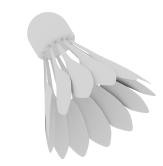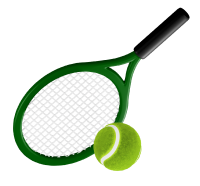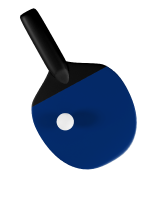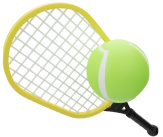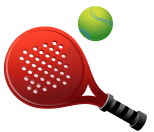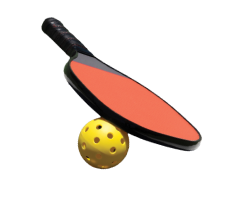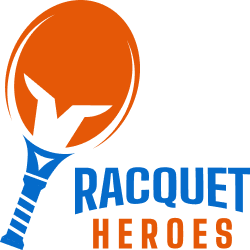Squash
Know all the basic Squash rules and regulations, how to play the game,
court lines, how to score points and more!
1. The Court
A squash court is a rectangular playing area bounded by four walls: the front wall, two side walls, and the back wall. The court has a level floor and a clear height above the playing area
1.1 Dimensions
- Length between playing surfaces: 9750 mm
- Width between playing surfaces: 6400 mm
- Diagonal: 11665 mm
- Height above floor to lower edge of front-wall line: 4570 mm
- Height above floor to lower edge of back-wall line: 2130 mm
- Height above floor to lower edge of service-line on front wall: 1780 mm
- Height above floor to upper edge of tin (bottom of front wall): 480 mm
- Distance from back wall to nearest edge of short-line: 4260 mm
- Internal dimensions of service boxes: 1600 mm
- Width of all lines: 50 mm
- Minimum clear height above the floor of the court: 5640 mm
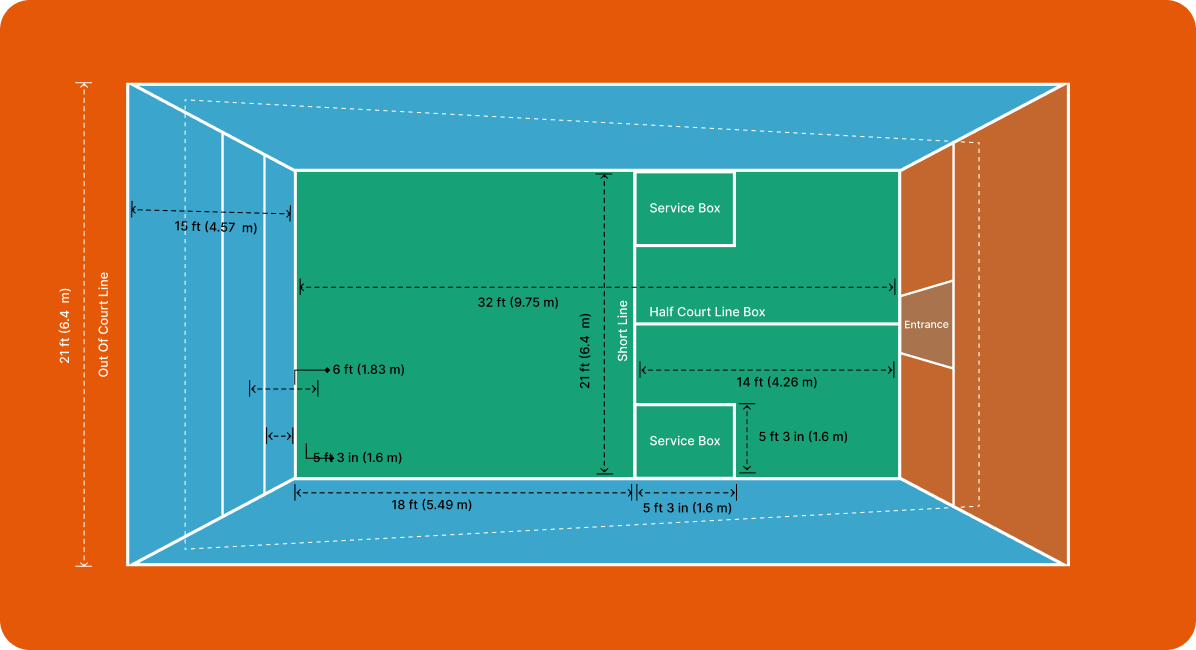
2. Squash Racket
2.1 Dimensions
- Maximum length: 686 mm
- Maximum width (measured at right angles to the shaft): 215 mm
- Maximum length of strings: 390 mm
- Maximum strung area: 500 sq. cm
- Minimum width of any frame or structural member (measured in the plane of strings): 7 mm
- Maximum depth of any frame or structural member (measured at right angles to the plane of strings): 26 mm
- Minimum radius of outside curvature of frame at any point: 50 mm
- Minimum radius of curvature of any edge of frame or structural member: 2 mm
2.2 Weight
- Maximum weight: 255 gm
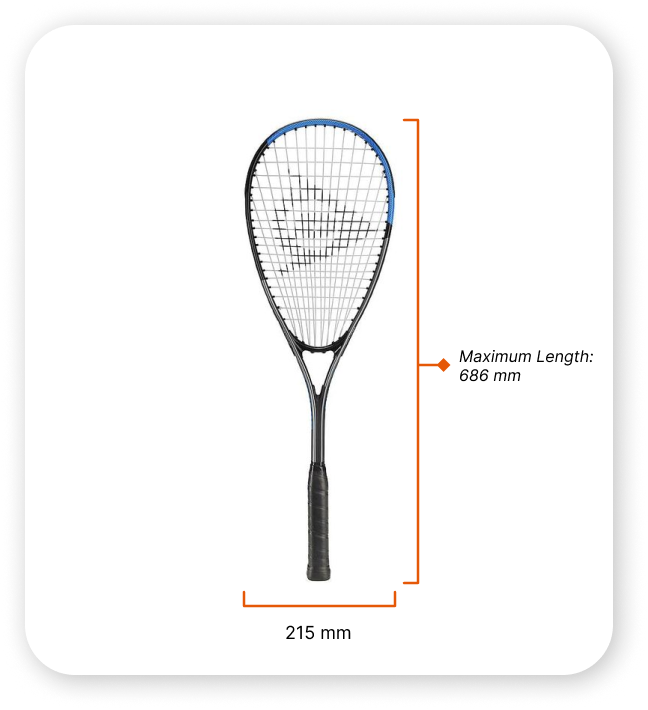
3. The Game

-
Singles Squash is played on a court between two players, each using a racket to strike the ball. The court, ball, and racket must comply with WSF specifications (see Appendices 7, 8, and 9).
-
The rally begins with a serve, and players alternate in returning the ball until the rally ends (see Rule 6: The Play).
-
Play must remain continuous as far as practical.
-
The winner of a rally scores one point and serves to start the next rally.
-
A game is played to 11 points, unless the score reaches 10-all, in which case play continues until one player leads by 2 points.
-
A match is typically played as the best of 5 games, but may be played as the best of 3 games.
4. The Ball

-
If the ball breaks during a rally, a let is allowed for that rally.
-
If a player appeals that the ball is broken and it is found not to be, the player loses the rally.
-
If the receiver appeals that the ball is broken before returning serve, and the ball is found broken, the Referee must allow a let for the previous rally if uncertain when it broke.
-
A player must immediately appeal the condition of the ball at the end of a game, before leaving the court.
-
The ball must be changed if both players agree or if the Referee approves a player’s request.
-
After a ball is replaced or the match resumes following a delay, players may warm up the ball. Play resumes when both players agree or at the Referee’s discretion.
-
The ball must remain in the court at all times unless permitted by the Referee to be removed.
-
A let is allowed if the ball becomes wedged in any part of the court.
-
A let may be allowed if the ball touches any article in the court.
-
No let is allowed for any unusual bounce.
5. Scoring System
5.1 Point-a-Rally Scoring is Modified as follows
-
The winner of a rally scores 1 point and serves to begin the next rally.
-
Each game is played to 15 points. If the score reaches 14-all, the game continues until one player leads by 2 points.
-
A match is generally played as the best of 5 games, but may be played as the best of 3 games.
6. Officials
6.1 Basics
-
A match is typically officiated by a Marker and a Referee, both responsible for keeping the score, noting the server, and ensuring the correct service box.
-
If only one official is present, that official assumes both roles of Marker and Referee. Players may appeal any call or lack of call by the Marker to the same official acting as the Referee
-
Officials should be seated at the center of the back wall, close to the wall and above the out-line.
-
An alternative officiating system, the 3-Referee System, Officials must address players by their family name, where possible.
- When addressing players, Officials must use the family name, where possible.
6.2 The Marker
-
Announce the match, introduce each game, and announce the result of each game and the match
-
Call “fault,” “down,” “out,” “not up,” or “stop” as necessary.
-
Make no call if unsure about a serve or return.
-
Call the score immediately at the end of a rally, with the server’s score first, and announce “hand out” when there is a change of server.
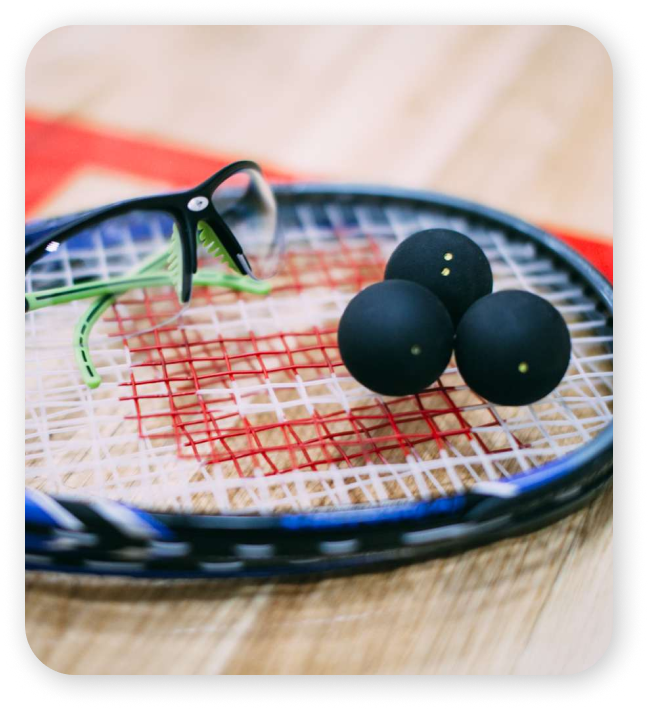
-
Repeat the Referee’s decision after a player requests a let, then call the score.
-
Wait for the Referee’s decision after an appeal against a Marker’s call, then announce the score.
-
Call “Game Ball” when a player needs 1 point to win a game or “Match Ball” when a player needs 1 point to win the match.
-
Announce “10-all: a player must win by 2 points” when the score reaches 10-all for the first time in a game.
6.3 The Referee (Final Authority)
-
Postpone the match if the court is unsuitable, or suspend play and allow the score to stand if resumed later.
-
Allow a let if external court conditions affect a rally.
-
Award the match if an opponent fails to be ready to play within the stipulated time.
-
Rule on all matters, including requests for a let and appeals against the Marker’s call.
-
Overrule the Marker’s call immediately if necessary, stopping play if required.
-
Correct the score if the Marker announces it incorrectly.
-
Enforce time rules, including announcements of “15 seconds,” “Halftime,” and “Time.” Players are responsible for hearing these announcements.
-
Make decisions if the ball hits either player.
-
Allow a let if unable to decide on an appeal.
-
Request clarification from a player if unsure about the reason for a let or appeal.
-
Provide explanations for decisions when appropriate.
-
Announce decisions loudly enough to be heard by players, the Marker, and spectators.
-
Apply Rule 15 (Conduct) for unacceptable player behavior.
-
Suspend play if non-player behavior is disruptive until it ceases or the offending individual leaves the court area.
7. Warm-Up
-
At the start of the match, players are allowed a maximum of 4 minutes to warm up the ball. After 2 minutes, players must change sides unless they have already done so.
-
Players must have equal opportunities to strike the ball. Retaining control of the ball for an unreasonable time constitutes unfair warm-up, and Rule 15 (Conduct) will be applied.
8. Serve
-
The player who wins the spin of the racket serves first.
-
At the start of each game and after each change of server, the server selects which service box to use. While retaining the serve, the server must alternate between the service boxes.
-
If a rally ends in a let, the server serves again from the same box.
-
If the server serves from the wrong box, or if there is uncertainty, the Marker must inform the players of the correct box.
-
In case of a dispute regarding the correct box, the Referee makes the final decision.
-
After the score is called by the Marker, play must resume without unnecessary delay. However, the server must wait for the receiver to be ready before serving.
8.7 A serve is valid if:
-
The ball is dropped or thrown from the server’s hand or racket and struck correctly before touching anything else.
-
The server’s foot is inside the service box and does not touch the box boundaries.
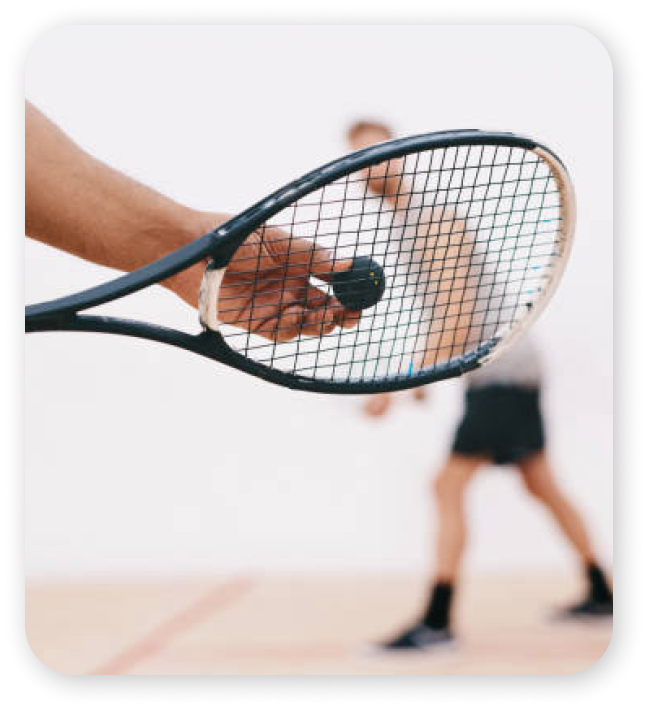
-
The ball is struck directly to the front wall, between the service line and the out-line, without touching both the front and side walls simultaneously.
-
The ball bounces for the first time in the opposite quarter-court without touching any line, unless volleyed by the receiver.
-
The ball is not served out
-
A serve that does not comply with Rule 5.7 is a fault, and the receiver wins the rally.
-
If the server drops or throws the ball without attempting to strike it, it is not considered a serve, and the server may start again.
-
A let is allowed if the receiver is not ready and does not attempt to return the serve. However, if the serve is a fault, the server loses the rally.
-
If the server serves from the wrong service box and wins the rally, the rally stands, and the server will then serve from the alternate box.
-
The server must wait for the Marker to call the score before serving. If the score is not called, the Referee must stop play and instruct the server to wait.
9. The Play
9.1 Play continues if the serve is good, and each return is valid, or until a player requests a let, makes an appeal, or an Official makes a call. The rally ends if the ball hits either player, their clothing, or the non-striker’s racket.
-
The ball is struck before it bounces twice on the floor.
-
The ball hits the front wall, either directly or after striking any other wall(s), above the tin and below the out-line, without touching the player, clothing, or racket.
-
The ball rebounds from the front wall without touching the tin.
-
The ball is not out.

10. Intervals
-
A maximum of 90 seconds is allowed between the end of the warm-up and the start of play, and between each game.
-
Players must be ready to resume play at the end of any interval, but play may resume earlier if both players agree.
-
A maximum of 90 seconds is permitted for changing damaged equipment, including glasses, protective eyewear, or dislodged contact lenses. Players must complete the change promptly, or Rule 15 (Conduct) will apply.
-
Players may strike the ball during any interval.
11. Interface
11.1 After completing a reasonable follow-through, the striker must clear the way for the opponent to:
-
Have a clear view of the ball.
-
Have unobstructed access to the ball.
-
Have space to make a reasonable swing.
-
Have the freedom to strike the ball to any part of the front wall.
11.2 Play continues if the serve is good, and each return is valid, or until a player requests a let, makes an appeal, or an Official makes a call. The rally ends if the ball hits either player, their clothing, or the non-striker’s racket.
11.3 If interference occurs but the striker strikes the ball and the opponent requests a let ,The rally is awarded to the opponent if the ball is down or out.
11.4 General Interference Provisions
-
No let is allowed if there was no interference or reasonable fear of injury.
-
No let is allowed if the striker couldn’t make a good return despite interference.
-
No let is allowed if the striker continued play after interference and then requested a let.

-
No let is allowed if interference did not prevent the striker from making a good return.
-
A stroke is awarded to the striker if the opponent failed to avoid the interference.
-
A let is allowed if the opponent made every effort to avoid interference and the striker could have made a good return.
-
A stroke is awarded if interference prevented the striker from making a winning return.
11.5 Specific Situations
-
Fair view means enough time to see and prepare to strike the ball after it rebounds from the front wall.
-
If the striker requests a let for lack of fair view, the provisions of 8.5 apply.
-
A let is not allowed if the striker did not make every effort to reach the ball.
-
A let may be allowed if the striker was wrong-footed but could recover and make a good return.
-
A let is allowed if the swing was affected by slight contact, but the striker could make a good return.
-
A stroke is awarded if the swing was blocked by contact with the opponent, even if the opponent tried to avoid it.
-
No let is allowed if the striker caused interference by using an excessive swing.
-
A let is allowed if the striker exaggerated the swing to earn a stroke.
-
A stroke is awarded if the striker refrains from striking due to front-wall interference and the ball would have hit the non-striker.
-
A let is allowed if the ball would first have hit the non-striker and then a side wall.
-
A let is allowed if the striker requests one while making a further attempt to strike the ball, and could have made a good return.
-
A stroke is awarded if the swing is prevented while turning, even if the opponent tried to avoid interference.
-
A let is allowed if the non-striker couldn’t avoid the interference while the striker was turning.
-
No let is allowed if the striker turns to create an opportunity for a let.
-
The Referee must consider whether the striker’s turning action is dangerous and rule accordingly.
12. Ball Hitting a Player
12.1 If the ball hits the non-striker or their racket/clothing while heading to the front wall
-
If the return wouldn’t have been good, the non-striker wins.
-
If the return was going to the front wall and the striker was making their first attempt, the striker gets a stroke.
-
If the ball would hit another wall before the front wall and the striker hasn’t turned, a let is allowed, unless the return would have won the rally, in which case a stroke is awarded to the striker.
-
If the striker hasn’t turned but was attempting another shot, a let is allowed.
-
If the striker has turned, the non-striker gets a stroke, unless the non-striker deliberately tried to intercept, in which case the striker gets a stroke.
-
If the ball hits the non-striker before the striker attempts a shot and no interference occurs, the striker wins the rally unless the striker’s position caused the non-striker to be hit, in which case a let is allowed.
-
If the ball hits the non-striker after the striker has made an attempt, a let is allowed unless the striker could not have made a good return, in which case the non-striker wins.
-
If the striker is hit, and there’s no interference, the non-striker wins. If interference occurs, Rule 8 (Interference) applies.
13. Appeals
-
Either player may appeal during a rally by saying “Appeal, please.”
-
The loser of a rally may appeal any call by the Marker by saying “Appeal, please.”
-
If the referee is unsure about the appeal, they will ask for clarification. Multiple appeals will be considered individually.
-
No appeals are allowed after the serve, except for a broken ball.
-
Appeals about the last rally must be made immediately at the end of a game.
13.6 In Response to an Appeal
-
If the Marker’s call was correct, the rally result stands.
-
If the Marker’s call was incorrect, a let is given, or if it interrupted a winning return, the rally is awarded to the player.
-
If the Marker didn’t call a bad serve/return, the rally is awarded to the other player.
-
If the referee is unsure about a serve or return, a let is given.
This content is derived from the “Squash Singles Rules” by the World Squash Federation (WSF)



